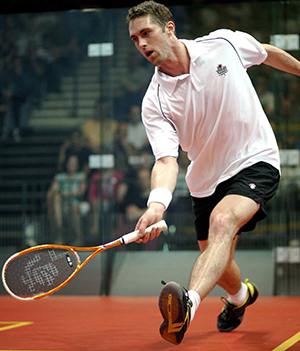|
|

Trends in Stringing: PEEK vs. Nylon II
By Steve Crandall
Vice President, Sales & Marketing
Ashaway Racket Strings

David Palmer, a two-time World and four-time British Open champion, is now in his second year coaching at Cornell University. He also still runs his Squash Academy and is one of the principals of Black Knight racquets. He still plays doubles and exhibitions, and he's on the court almost daily, feeding shots and volleying with his players. He likes MultiNick® 18 because it provides both the power and control he needs, and is also very durable. |
In our last column, in which we looked at the differences between PEEK and PU-based multifilament nylon squash strings, we cautioned that, "the same string will really play and feel differently for different players." This was underscored not too long after, when we asked two of the game's top players, past and present, why they chose different strings, and they gave us essentially the same answer!
David Palmer, who needs no introduction here, recently switched from PEEK-based UltraNick® 18 to the new PU-based MultiNick® 18. Amanda Sobhy, one of the most exciting young players on the tour, playtested MultiNick 18, but decided to stay with UltraNick. Both said they liked the "power and control" they got from the strings.
Amanda's comments were, "I like the feel of the UltraNick 18 string and its durability. It gives me a lot of control when I need it, as well as the crisp power to hit a hard shot in any position on the court. That is what I go for in my game, so I want the strings I use to match my style of play."
This makes sense for Amanda, who reached No. 6 in the world - the highest Professional Squash Association ranking ever achieved by an American woman - before being sidelined by injury in 2017. She's back on the tour now, and if you've ever watched her play, you've seen how dynamic she is on the court.
But her comment also makes sense for UltraNick, as the dynamic stiffness of its PEEK multifilament fibers give it the ability to stretch and snap back quickly, returning power and energy to the ball.
David's comment was more puzzling because we didn't intend MultiNick to be what is normally considered a power string. But after switching to it at last year's Commonwealth Games, where he won the Gold Medal in Men's Doubles at the age of 41, he told us, "The power was great, and I still felt I had good control over the ball and could move it around wherever I wanted. For doubles it's important to have that power when you need it, but with the ball control as well. It also lasted. That's the other thing, it has good durability. I had two racquets strung up just at the start of the tournament and the string lasted the whole way through. For me, that's nice as well, not having to worry about someone else stringing my racquets."
David, a two-time World and four-time British Open champion, is now in his second year coaching at Cornell University. He also still runs his Squash Academy and is one of the principals of Black Knight racquets. So he's not active on the tour as he once was, but he still plays doubles and exhibitions here and there, and he's on the court almost daily, feeding shots and volleying with his players. So having the right string in his racquet is still very important to him. We asked him to explain further.
"Normally you have a string that's either good for power or is focused on providing good control and touch on the ball," he said. "With the MultiNick, I get both aspects. I've used strings in the past because I wanted to hit the ball harder. And at times I've had string which has less power, but more touch. I feel the new string is great for both. I can hit the ball hard and it responds really powerfully, and when I need to -- like on shots at the front of the court, the more attacking delicate type of shots, the volley drops -- I feel like I have really good control of the ball as well. I've been using it when I'm coaching and a lot of my kids have switched over and really like it as well."
So, can a string provide both power and control? Far be it from us to doubt the likes of David Palmer, but what we think is going on has to do with dwell time. Because PU based strings like MultiNick 18 are softer, the ball stays on the strings just a little bit longer. We're talking milliseconds here, but this allows the racquet to use leverage to generate power, like a lacrosse stick. So you feel like you are really whipping the ball off the racquet, as opposed to Zyex based strings where you get that crisp feeling of the ball popping off the string bed really fast. That leverage could also allow players to really rifle their shots exactly where they want them: especially players like David who has always been known as a superb technician.
What's your verdict? Do you get better power and control from PEEK or PU-based multifilament nylon string? Let us know and perhaps we can discuss the results in a future column.
ZYEX® is a registered trademark of Victrex Ltd.
This article previously appeared in Squash Magazine
Steve Crandall is Vice President of Marketing and Sales at Ashaway Racket Strings. Part of the sixth generation to run the family-owned business, he is a lifelong racket sports fan and well-known writer and commentator on all things string. Follow him on Instagram at ashawayusastring
|

